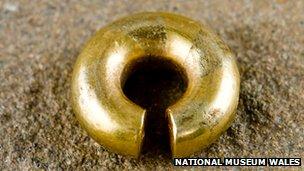Bronze age axes from the Vale of Glamorgan declared treasure
- Published

The axes were found carefully arranged and buried together
A hoard of 3,000-year-old axes from the late Bronze Age found by a man with a metal detector in the Vale of Glamorgan has been recorded as treasure.
The axes - most of which were complete - were found buried together on farm land in Colwinston in April 2012.
National Museum Wales experts say the axes from around 1000-800BC could have been buried as gifts to the gods.
They were declared treasure at an inquest in Cardiff.
National Museum Wales is keen to acquire the axes, which are all datable to the Ewart Park metalworking tradition of the Late Bronze Age.
The Bronze Age in Britain is thought to have started around 2000BC and is regarded as a crucial period that linked the Stone Age with the Iron Age.
Archaeologists who investigated the site where the axes were found discovered that they were buried in a specially dug pit, seemingly some distance away from any Bronze Age settlement.
"The finder's account of the positioning of the axes when found suggests the objects were buried in the ground in a precise and careful way," said Adam Gwilt, curator of the Bronze Age Collections at National Museum Wales.
"It is possible that the hoard was placed as a gift to the gods during a ceremony held by the local Bronze Age farming and metalworking community."
Medieval silver
Mary Hassell, the Cardiff and Vale of Glamorgan coroner, also declared as treasure a Bronze Age ring that was found by another man using a metal detector in the Vale of Glamorgan.
The penannular ring - an ornament whose function is unknown - was found on farm land in St Donats in January last year.

A penannular ring was found on farm land in St Donats, Vale of Glamorgan
Experts at the museum said it was an example of a hair-ring - a small item of jewellery which may have been worn as an earring, although some archaeologists believe they were a form of hair decoration.
Analysis of the ring found it was made of copper covered with gold foil.
Hair-rings have been discovered in significant numbers across Ireland, Britain, Belgium, north east France and the Netherlands.
This is the sixth known example from Wales, with others known from Swansea, Carmarthenshire, Anglesey and Gwynedd.
In addition, three late medieval silver objects found in the Vale of Glamorgan were also declared as treasure at the inquest.
A dress hook from Llanfair, a ring from St Donats and another ring from Gileston, all dated back to the 15th and 16th Centuries.
National Museum Wales said it was keen to acquire all of the objects following their independent valuation.
- Published24 February 2012
- Published19 April 2012